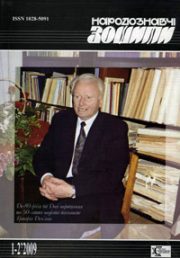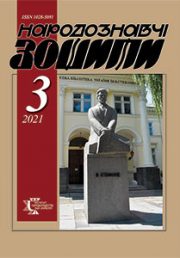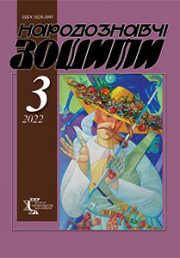The Ethnology Notebooks. 2022. № 1 (163), 236—242
UDK 398.332.4(477.87+438+437.6=161.2):82-94
DOI https://doi.org/10.15407/nz2022.01.236
FINAL CYCLE OF CHRISTMAS HOLIDAYS IN LEMKIVSHCHYNA
HORBAL Маrіa
- ORCID ID: https://orcid.org/0000-0001-9287-8336
- Leading Scientific Editor,
- Institute of Ethnology of the National
- Academy of Sciences of Ukraine,
- 15, Svobody Avenue, 79000, Lviv, Ukraine,
- Contacts: e-mail:horbal.m@gmail.com
Abstract. Outlined topics. Conventionally, Christmas holidays in Lemkivshchyna, as well as throughout Ukraine, can be divided into three cycles — pre-Christmas, Christmas itself, and the final Christmas cycle. The basis of the Christmas cycle of holidays is the commemoration of the birth of the Son of God (at Christmas) and the witnessing of the divine nature of Jesus Christ during baptism in the Jordan River (Epiphany).
A characteristic feature of the whole cycle of Christmas holidays, which manifests itself in the third, final cycle, is the unity of nature — divine, human, plant and animal, living and dead: the unity of the family in prayer with the Son of God and with the souls of deceased relatives during the Holy Supper (at the Holy Supper on Christmas day and on Epiphany), respectful treatment of plant (fruit trees) and animal (livestock) world.
One of the forms of communication of all members of the genus is a Christmas meal: at one table, the consumption of a ritual dish — from one vessel.
The family’s meals at the same table are an established and rooted tradition of descendants of all the Proto-Slavic peoples, which is still honored to this day.
The purpose of the article is to analyze the third, final Christmas cycle in Lemkivshchyna, which embraces the Epiphany holiday, the feasts of the Three Saints, and the Feast.
The relevance of the study is to gather and recreate the cultural heritage of people who have lost their ethnic land and are now scattered around the world, engulfed in assimilative processes.
The source base was mainly the memories of Lemkos deported from ethnic lands.
The author concludes that the third, final period of the Christmas holidays (as well as the entire Christmas cycle) testifies to the triumph of spiritual exaltation, mutual respect, mutual responsibility, which is an expression of culture based on the gene memory of the people. And the roots of this behavior are embedded in the high morality of Christian teaching.
The research methodology is based on the application of the principles of science, objectivity and historicism; in the process of research, methods of field ethnographic research were used, in particular interviewing respondents.
Keywords: Lemkivshchyna, Jordan, Christmas Eve, Epiphany, feast of the Three Saints, Feast, holy water, candles.
Received 16.02.2022
REFERENCES
- Horbal, M. (2018). Lemkivsky «vehirky» («vehyrky», «vehurky», «spinning wheels»). The Ethnology notebooks, —3 (141), 608—617 [in Ukrainian].
- Horbal, M. 2019).Lemkivsky «vehirky» («vehyrky», «vehurky», «spinning wheels»). Lviv: Institute of Ethnology of the National Academy of Sciences of Ukraine [in Ukrainian].
- Horbal, M. (2011). Christmas rituals of Lemko region: semantics, typology, ethnic context. Lviv: Institute of Ethnology of the National Academy of Sciences of Ukraine [in Ukrainian].
- Horbal, M. (Ed.). 2004). Christmas in the Lemko region. Folklore and ethnographic collection. Lviv: Institute of Ethnology of the National [in Ukrainian].
- Horbal, M. (Ed.). 2009).Christmas tree: Lemko Christmas legends and legends. Lviv: Institute of Ethnology of the National [in Ukrainian].
- Sivitsky, M. 1988). North. Spiritual culture. Lemkivshchyna. Earth-people-history-culture. Notes of the NTSh (Vol. 2, pp. 114—116) [in Ukrainian].
- Mushinka, M. 1988). South. Spiritual culture. Lemkivshchyna. Earth-people-history-culture. Notes of the NTSh. (Vol. 2, pp. 301—302). New York [in Ukrainian].
- Stavisky, J. (2015). Generous evening and generous hearts in the well. Bonfire, 2 (89), 22 [in Ukrainian].
- Gurgula, I. (1937). Jordanian straw crosses from Uhniv region. Our homeland, 1. Retrieved from: https://photo-lviv.in.ua/yordanski-solom-iani-khreshchyky-z-uhnivshchyny/?fbclid=IwAR1U3hugkKoioN36AyqeoVFqI8JwcJA-7ZTXuV8XhhX9ghzrfQ4 [in Ukrainian].
- Sapanyuk, M. History of Christmas. Retrieved from: https://horyn.info/news/istoriya-svyata-rizdva-hrystovogo/ [in Ukrainian].







